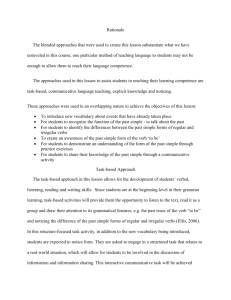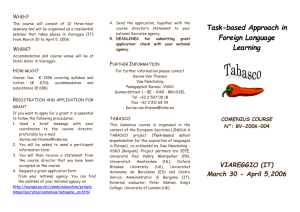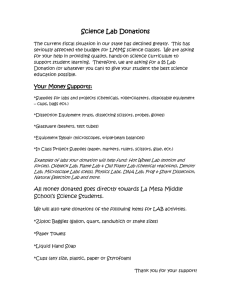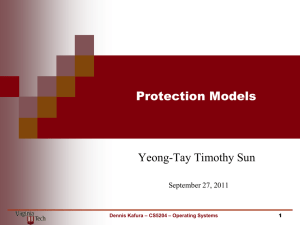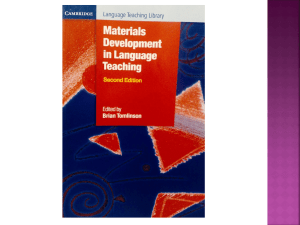ERIC Identifier: ED343407
advertisement
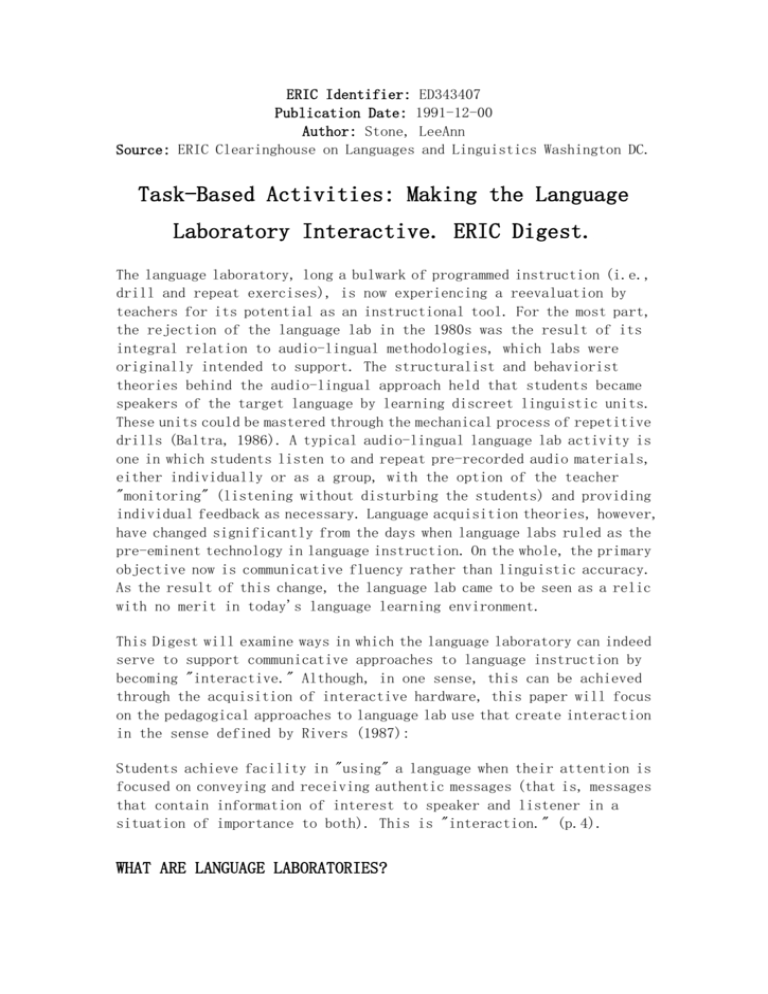
ERIC Identifier: ED343407 Publication Date: 1991-12-00 Author: Stone, LeeAnn Source: ERIC Clearinghouse on Languages and Linguistics Washington DC. Task-Based Activities: Making the Language Laboratory Interactive. ERIC Digest. The language laboratory, long a bulwark of programmed instruction (i.e., drill and repeat exercises), is now experiencing a reevaluation by teachers for its potential as an instructional tool. For the most part, the rejection of the language lab in the 1980s was the result of its integral relation to audio-lingual methodologies, which labs were originally intended to support. The structuralist and behaviorist theories behind the audio-lingual approach held that students became speakers of the target language by learning discreet linguistic units. These units could be mastered through the mechanical process of repetitive drills (Baltra, 1986). A typical audio-lingual language lab activity is one in which students listen to and repeat pre-recorded audio materials, either individually or as a group, with the option of the teacher "monitoring" (listening without disturbing the students) and providing individual feedback as necessary. Language acquisition theories, however, have changed significantly from the days when language labs ruled as the pre-eminent technology in language instruction. On the whole, the primary objective now is communicative fluency rather than linguistic accuracy. As the result of this change, the language lab came to be seen as a relic with no merit in today's language learning environment. This Digest will examine ways in which the language laboratory can indeed serve to support communicative approaches to language instruction by becoming "interactive." Although, in one sense, this can be achieved through the acquisition of interactive hardware, this paper will focus on the pedagogical approaches to language lab use that create interaction in the sense defined by Rivers (1987): Students achieve facility in "using" a language when their attention is focused on conveying and receiving authentic messages (that is, messages that contain information of interest to speaker and listener in a situation of importance to both). This is "interaction." (p.4). WHAT ARE LANGUAGE LABORATORIES? Technically, a language laboratory is an instructional technology tool consisting of a source unit that can disseminate audio materials to any number of students at individual seats or carrels. Language labs can be categorized into three levels. In level I labs, students passively listen (usually through headsets) to audio materials emanating from a single source unit. The students may repeat the materials they hear, but are not able to "self monitor" through feedback from headsets. Level II labs provide the self-monitoring option through the addition of a microphone to each headset. In both Level I and II labs, students are restricted to working at the same rate on any given assignment because the only audio source is the teacher's console. Level III labs break this restriction by providing students with a tape recorder, video monitor, and/or computer at each carrel. Thus, at the teacher's discretion, the student has access to the full range of controls including playback, record, and review. Level I and II labs are limited to programmed instruction because of their single distribution source. It is with Level III labs in mind that we consider making the lab interactive and creating communicative environments. HOW CAN THIS TRANSITION BE MADE? The history of computer-aided language instruction provides a model for reevaluating the role of the language lab. Like language labs, computers came into the arena as a means of providing programmed instruction. In the early days, computer programs were designed to replace the teacher in the more mundane tasks of drilled exercises. Within a relatively short period of time, new approaches for computer use were developed. Dubbed "computer assisted language learning" (CALL), these programs broke from the programmed instruction approach taken by the earlier computer-assisted instruction (CAI), to take a new, communicative-oriented, teacher-directed, task-based approach to computer use (Jones, 1986; Baltra, 1987). One of the reasons that computers were able to make the transition from programmed instruction (CAI) to more interactive approaches (CALL) without the rejection that language labs faced was that computers were not created as an intrinsic component of the audio-lingual approach. Another reason was that computers, unlike language labs, had an infinite range of applications outside the field of language learning. Educators, then, did not have preconceived ideas regarding the limitations of computers (as they had with language labs), but looked forward to their increasingly expanding potential. To see the language laboratory as a tool in this light is the first step in the reevaluation process. The next step is to glean ideas from CALL, as well as from other areas, that can be adapted to more appropriate uses in the language lab. Task-based activities are a means of integrating interactive learning through use of the language lab. These activities look at the language laboratory in the same way that CALL looks at the computer: as a tool that requires teacher direction in creating situations in which the students utilize the target language to attain some non-language-related objective. The distinction between task-based language lab activities and programmed instruction is essentially the same as that between CALL and CAI: one focuses on communicative fluency, the other on linguistic accuracy. WHAT ARE THE CHARACTERISTICS OF TASK-BASED ACTIVITIES? There are three main criteria for task-based activities. First, they have a goal or purpose that requires the use of the target language, but is not itself centered on that language. For example, each student writes and tape records a story about an invented vacation. Students then listen to the stories and evaluate them in terms of which vacation they would most like to take themselves. The students' goal is to tell a story that interests and excites their peers. The focus is on the story rather than on the language itself; however, the means to the end is through effective communication in the target language. The second criterion involves making use of the unique features of a language lab to create a learning environment that cannot be recreated in the regular classroom. Activities such as cloze exercises based on music passages are not lab-specific. Such an activity can be accomplished as well, or perhaps even better, with a portable tape recorder in the regular classroom. On the other hand, some group-oriented classroom-based activities can be improved by adapting them to the language laboratory. For example, paired activities involving one student describing something or giving directions to another student may be better accomplished in the language laboratory than in the classroom. Lab pairing eliminates the opportunity for students to see or show the materials they are working with, and thus heightens listening comprehension and questioning skills. Telephone conversations are another activity ideally suited in this way for the language lab. An activity such as "Murder in the Lab" utilizes the unique features of the language laboratory in an even more sophisticated way. In this activity, the teacher prepares a number of tapes with information regarding the people, places, and activities involved in a murder. The students' task is to determine, after listening to the various tapes (each placed in different carrels throughout the lab), who the murderer is. The students work in pairs or small groups and listen, discuss, reason, and draw a conclusion. At the end of a given period of time, the teacher brings the students together for a discussion about the crime. The third characteristic of a task-based activity is that it involves the student in a way that intrinsically motivates, lowers the affective filter, and creates a desire to excel. One element of motivation is to want something. "To want something is to be motivated, and motivation initiates and sustains involvement in learning" (Spithill, 1980, p.72). Task-based activities, then, can be designed to provide students with the opportunity to want something. Take the "Murder in the Lab" example: The students want to solve the murder. In the case of the vacation activity cited earlier, the students are motivated by a desire to be creative and to impress their peers. This opportunity to be inventive itself becomes a motivator as the students' self-esteem is enriched through the positive feedback received from their peers. WHAT IS THE ROLE OF TASK-BASED LAB ACTIVITIES? The role of task-based activities is to provide learners with opportunities to use the target language contextually, and to explore the target language through situational activities. In this way, the language lab can serve as an invaluable tool in the language learning and teaching process, for it provides opportunities for learning that cannot be duplicated in the classroom. A tool, however, is only as effective as its implementor, and thus the role of the teacher is central to the success of task-based activities. The aim of patterned lab drills was to provide a mechanical means to free the teacher for other instructional activities. Task-based activities bring the teacher back into the lab. The role of the teacher has been summarized by Rivers (1987): Part of the teacher's art is to create, or stimulate student creation of, the types of situations in which interaction naturally blossoms and in which students can use for actual communication what they have been learning in a more formal fashion. (p.4) REFERENCES Baltra, A. (1986). "Computer assisted language learning: What is it all about?" Paper presented at a conference at the University of California, Irvine. Baltra, A. (1987). "Cooperative Learning, communicative software, and teachers as stage directors." Paper presented at the Annual Meeting of the Teachers of English to Speakers of Other Languages, (Miami, FL, April 21-25). Jones, C. (1986). It's not so much the program, more what you do with it: The importance of methodology in CALL. "System, 14"(2), p.171-78. Rivers, W. (Ed.). (1987) "Interactive language teaching." NY: Cambridge University Press. Spithill, A.C. (1980). Motivation and language teaching. "Hispania, 61"(1), p.72-75. ----FOR FURTHER READING Ely, P. (1984). "Bring the lab back to life." NY: Pergamon Press. Linder, C. (Ed.). (1977). "Oral communication testing: A handbook for the foreign language teacher." Lincolnwood, IL: National Textbook Co. Stone, L. (1988). "Task-based activities: A communicative approach to language laboratory use." Philadelphia, PA: International Association for Learning Laboratories.

